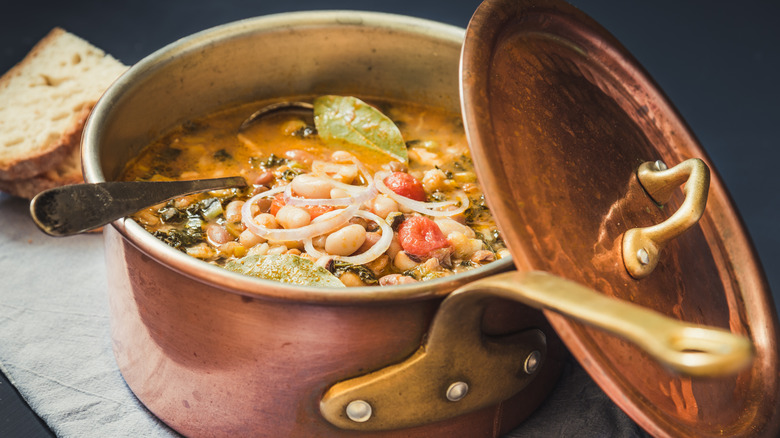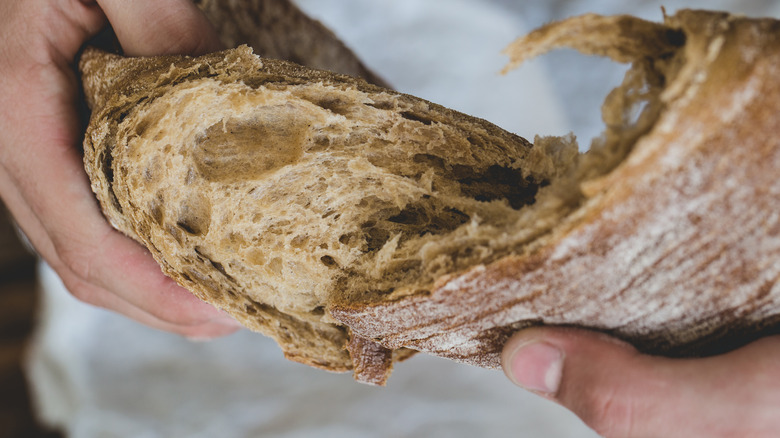Hearty Italian Ribollita Soup Makes Good Use Of Stale Bread
One of the many Italian contributions to warm comfort-in-a-bowl dishes is the rustic ribollita — a soup that is quintessentially Tuscan with its hearty mix of vegetables, beans, and, of course, crusty bread. As a dish of peasant origins from the Middle Ages, it evolved as a way to repurpose leftover vegetables and soup, with stale bread added to make it more filling; its name literally translates to "re-boiled," which is how the soup was stretched for days.
The practice of adding bread to soup is a product of the cucina povera, a cooking philosophy consisting of techniques that originated amongst Italy's peasant population and focused on frugality and stretching every ingredient. Meat was at a premium, and meals usually consisted of cheaper high-calorie carbs like bread or pasta, along with seasonal fruits, vegetables, and beans. Other cucina povera classics include spaghetti aglio e olio, pasta e fagioli (pasta with beans), and the Panzanella salad, which also uses stale bread as a crowning touch.
Contemporary ribollita is not reboiled over days but served as a wholesome, freshly made dish that's also vegan-friendly. What's not changed is the practice of adding chunks of stale bread, which turn into soup-soaked morsels reminiscent of dumplings, which upgrade the dish from thin soup to a filling meal. The fact that it's stale helps the bread hold together in the soup, as most fresh bread, when combined with hot soup, will turn instantly to mush. However, mushy bread in ribollita is not necessarily a bad thing.
Bread lets you customize the texture of ribollita soup
The beauty of ribollita is its simplicity, and like several Italian dishes, it is a worthy example of a dish that's greater than the sum of its parts. Basic vegetables and aromatics form a flavorful base, beans (traditionally cannellini, but other beans work as well) contribute protein and richness, and bread adds the textural contrast. As with the rest of the ingredients, you can play around with the type of bread you use in a ribollita, but remember that the original dish used the simplest variety of Tuscan bread.
Therefore, any crusty, rustic loaf works well, and you can even use a ciabatta or dry French baguette. What's more important is that you use big chunks of the bread in the soup so it can soak up the broth and provide that textural contrast with the beans and vegetables. Depending on the bread and how spongy you ultimately want it, play around with the time it spends in the soup before serving. Anything from a few minutes to a few hours, and even overnight, is fair game.
And what if you're craving ribollita today, but all you have on hand is fresh bread? Toasting it in the oven before dropping it in the soup is one way to proceed. However, fresh bread in ribollita is also quite delicious. As it breaks down, it thickens the soup, giving it a porridge or pudding-like consistency that's great for winter meals.
The medieval origins of ribollita soup
Its roots in cucina povera are apparent, but the more specific narrative associated with ribollita's origins takes us back to the Middle Ages when nobles were served meat atop unleavened Tuscan flatbreads. These pieces of bread, soaked with meat drippings, were then cooked in broth with vegetables and herbs to make a soup that would serve as a meal. As it was "reboiled" over days, the flavors of the ribollita intensified. Though ribollita's recipe doesn't seem to appear in records from that time, other recipes feature similarities, like the "Minestra di tutte le sorte d'erbe" (translated to "soup from all sorts of herbs"), a vegetable soup meant to be cooled and cooked repeatedly.
Theories differ on where the ribollita recipe as we know it first appeared, with some pointing to the "Guida gastronomica d'Italia" by the Touring Club Italiano, which was first published in 1931. The recipe does appear in "Il cucchiaio d'argento" (The Silver Spoon), a comprehensive Italian cookbook with close to 2000 recipes that was first published in 1950.
In either case, ribollita, though widely consumed in the Tuscan region, did not have a formally recorded recipe until a few centuries later. This dish remains as versatile as ever, open to most ingredients you may have on hand and living up to the deliciously simple philosophies of cucina povera that call for you to use a recipe merely as a guide and make the dish your own.


